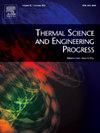Multi-layer neural network on 3D transition metal hydrides-based ternary nanofluid flow with entropy: Application to spinning disk reactor
IF 5.1
3区 工程技术
Q2 ENERGY & FUELS
引用次数: 0
Abstract
Artificial Neural Networks provide effective solutions to simulate and optimize complicated fluid systems, especially thermal management systems. This research examines the flow and heat transfer behavior of a ternary hybrid nanofluid made up of Titanium hydride , Lanthanum hydride , and Zirconium hydride nanoparticles dispersed in dihydrogen oxide in a spinning disk reactor. The governing equations, formulated in terms of conservation laws, are transformed to dimensionless ordinary differential equations by similarity transformations and solved numerically using MATLAB’s bvp4c solver. Artificial Neural Networks models are then used to capture nonlinear interactions and enhance prediction accuracy for important parameters such as skin friction and Nusselt number. The study shows that radial velocity decreases with higher Casson parameter, porosity and 2nd order radial slip, while azimuthal velocity increases for Casson parameter and 1st order radial slip but decreases for porosity. Temperature rises with thermal radiation and Brinkmann number but drops with Reynold number. Casson parameter and stretching parameter enhance skin friction but reduce the Nusselt number. Entropy increases with Brinkmann number but decreases with Casson Parameter. ANN models for first order tangential slip, porosity, and Casson parameter achieved , with minimal errors, ensuring reliability. First order tangential slip and porosity stabilized after more epochs, while Casson Parameter converged faster. MSE analysis confirmed accurate predictions, validating the model’s effectiveness.
三维过渡金属氢化物三元纳米流体熵流动的多层神经网络:在旋转圆盘反应器中的应用
人工神经网络为模拟和优化复杂的流体系统,特别是热管理系统提供了有效的解决方案。本研究考察了由氢化钛TiH2、氢化镧la3和氢化锆ZrH2纳米颗粒组成的三元杂化纳米流体在旋转圆盘反应器中分散在氧化二氢中的流动和传热行为。利用相似变换将守恒方程转化为无因次常微分方程,并利用MATLAB的bvp4c求解器进行数值求解。然后使用人工神经网络模型来捕获非线性相互作用,并提高对皮肤摩擦和努塞尔数等重要参数的预测精度。研究表明:径向速度随Casson参数、孔隙度和二阶径向滑移的增大而减小;方位速度随Casson参数和一阶径向滑移的增大而增大,随孔隙度的增大而减小。温度随热辐射和布林克曼数的增加而升高,随雷诺数的增加而降低。Casson参数和拉伸参数使表面摩擦力增大,但使Nusselt数减小。熵随Brinkmann数的增加而增大,随Casson参数的增加而减小。一阶切向滑移、孔隙度和Casson参数的ANN模型R≈1,误差最小,保证了可靠性。一阶切向滑移和孔隙度在较多的次元后趋于稳定,而Casson参数收敛速度较快。MSE分析证实了预测的准确性,验证了模型的有效性。
本文章由计算机程序翻译,如有差异,请以英文原文为准。
求助全文
约1分钟内获得全文
求助全文
来源期刊

Thermal Science and Engineering Progress
Chemical Engineering-Fluid Flow and Transfer Processes
CiteScore
7.20
自引率
10.40%
发文量
327
审稿时长
41 days
期刊介绍:
Thermal Science and Engineering Progress (TSEP) publishes original, high-quality research articles that span activities ranging from fundamental scientific research and discussion of the more controversial thermodynamic theories, to developments in thermal engineering that are in many instances examples of the way scientists and engineers are addressing the challenges facing a growing population – smart cities and global warming – maximising thermodynamic efficiencies and minimising all heat losses. It is intended that these will be of current relevance and interest to industry, academia and other practitioners. It is evident that many specialised journals in thermal and, to some extent, in fluid disciplines tend to focus on topics that can be classified as fundamental in nature, or are ‘applied’ and near-market. Thermal Science and Engineering Progress will bridge the gap between these two areas, allowing authors to make an easy choice, should they or a journal editor feel that their papers are ‘out of scope’ when considering other journals. The range of topics covered by Thermal Science and Engineering Progress addresses the rapid rate of development being made in thermal transfer processes as they affect traditional fields, and important growth in the topical research areas of aerospace, thermal biological and medical systems, electronics and nano-technologies, renewable energy systems, food production (including agriculture), and the need to minimise man-made thermal impacts on climate change. Review articles on appropriate topics for TSEP are encouraged, although until TSEP is fully established, these will be limited in number. Before submitting such articles, please contact one of the Editors, or a member of the Editorial Advisory Board with an outline of your proposal and your expertise in the area of your review.
 求助内容:
求助内容: 应助结果提醒方式:
应助结果提醒方式:


